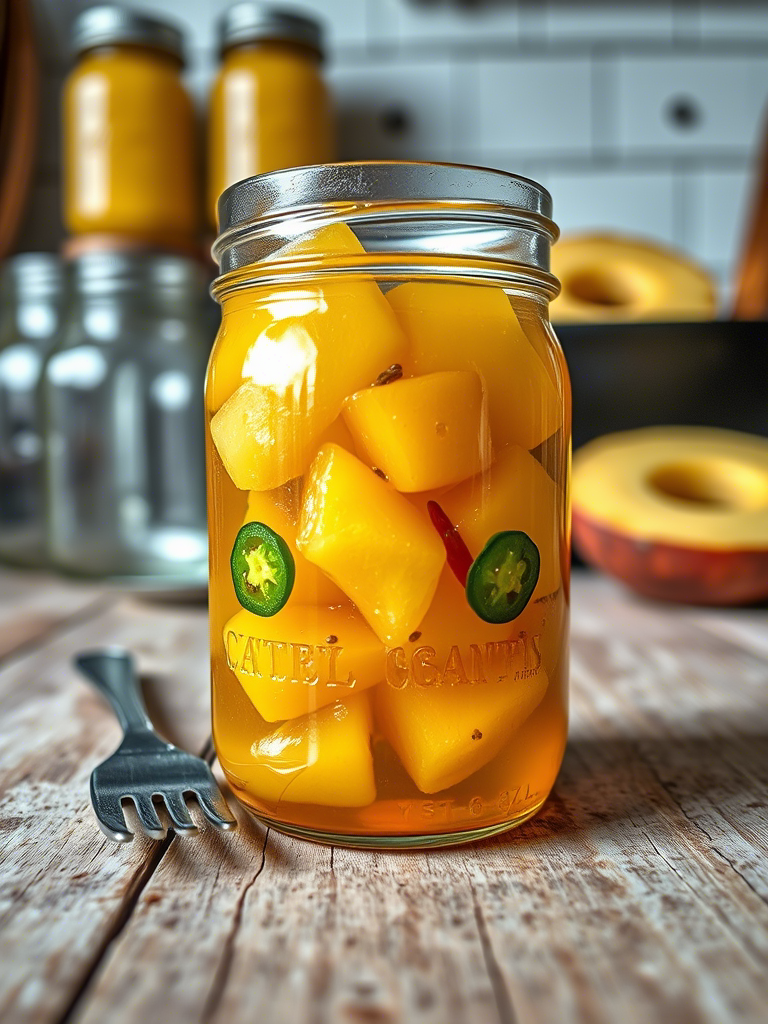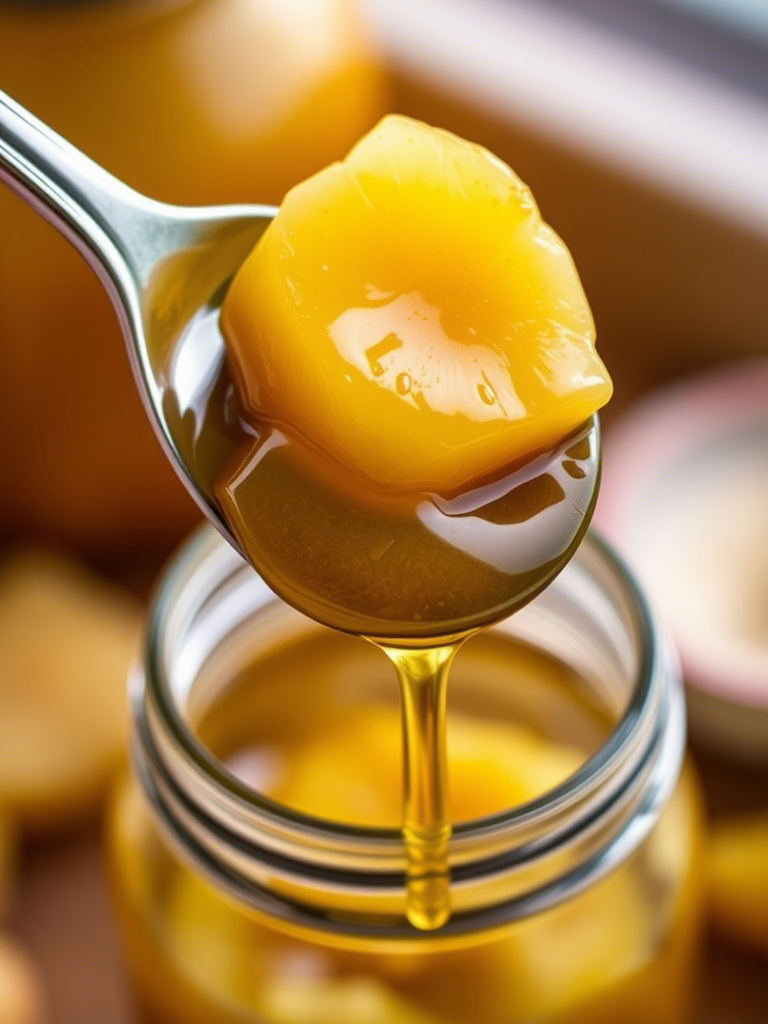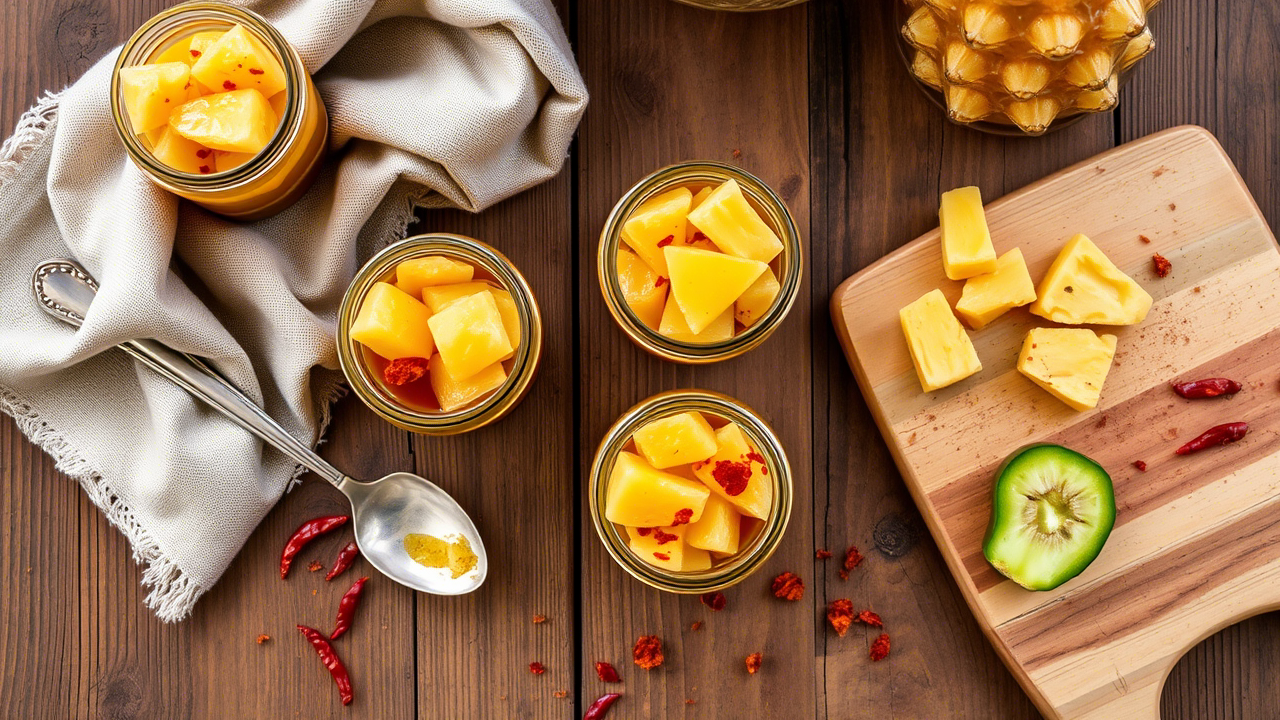There’s a wild little thing happening in kitchens lately—sweet, spicy, sticky, tangy chaos in a jar. It’s called Pineapple Cowboy Candy, and if you’re sleeping on it, you’re missing out on one of the most versatile, flavor-loaded preserves this side of the Mississippi.
Let’s not kid ourselves here. This ain’t your grandma’s pineapple jam. It’s a full-blown flavor grenade—sweet pineapple chunks simmered in a syrupy bath of sugar, vinegar, jalapeños, and spices. It plays nice on a cracker with cream cheese, sure. But it’ll also punch your pork chops into the flavor stratosphere.
If you’re a chef, a caterer, or the kind of home cook that wears out mandoline blades for fun—this one’s for you.
What Exactly Is Pineapple Cowboy Candy?
The original “Cowboy Candy” goes back to East Texas, where jalapeños were candied in syrup to preserve them. Think pepper jelly, but chunkier and a hell of a lot bolder. Somewhere along the way, pineapple joined the party—and things got real weird, real good.
In short, Pineapple Cowboy Candy is jalapeños and pineapple slices or chunks, cooked down with vinegar, sugar, and spices until everything becomes glassy, golden, and sticky as sin.
The magic? It’s the balance. You’ve got sweetness, acidity, heat, and umami all tangled together. It’s the kind of condiment that walks into a dish like it owns the place.
Why Pineapple?
First off, pineapple’s no sidekick here. It’s the whole show. High in bromelain, which breaks down protein, pineapple isn’t just tasty—it does something. That enzymatic edge helps tenderize meats. Grillers, take note.
But it’s the sugar-acid profile that seals the deal. Pineapple brings the kind of brightness that slices right through the jalapeño heat, giving you bite after layered bite without fatigue. It’s not hot for the sake of hot—it’s complex. That makes it ideal in professional kitchens where balance matters more than shock value.
The Science Behind the Sweet Heat
Let’s talk chemistry. The base of most Cowboy Candy recipes involves sugar (usually white or brown), vinegar (apple cider’s most common), and sliced jalapeños. Add pineapple and things get interesting.
Sugar acts as a preservative and enhances flavor by caramelizing slightly during the simmering process. Vinegar brings the pH down, essential for shelf-stability and safe canning. The jalapeños bring capsaicin to the table, which not only triggers heat receptors in the tongue but also stimulates appetite.
Pineapple, with its high acid content and fructose load, integrates seamlessly into this matrix. But here’s the twist: as the pineapple simmers, it soaks up heat from the peppers while surrendering its own juice into the syrup. That synergy creates a rounded burn—kind of like a gentle slap you want more of.

The Culinary Use Cases Are Endless
If you’ve only used Pineapple Cowboy Candy on a cracker, you’re missing the forest for the trees.
- Charcuterie Boards: Pineapple Cowboy Candy is a crown jewel beside brie, goat cheese, and cured meats. It cuts the fat, livens the plate, and draws attention.
- Glazes and Marinades: Mixed into BBQ sauces or directly applied to pork shoulder, chicken thighs, or ribs before grilling. The sugars help caramelize the crust while the acids penetrate and tenderize.
- Cocktails: Bartenders are infusing it into mezcal margaritas or spicy piña coladas. Syrup and all.
- Burgers and Sandwiches: Add it to a pulled pork sandwich or under a smash burger patty. The heat hugs the fat like it was born to.
- Pizza: Yes, pineapple on pizza is divisive. This version shuts down the debate. Add it with bacon or sausage and watch faces melt—in a good way.
One chef I spoke to out in Austin told me they keep a rotating batch in-house and use it in everything from brisket tacos to ramen broth. No joke.
A Word on Heat Levels
Not all jalapeños are created equal. And neither are pineapples, for that matter. Depending on the crop, your heat levels can swing wildly. For commercial or restaurant use, test your peppers in advance or consider blending with a milder chili like Fresno or Hungarian wax for consistency.
Got customers who cry at sriracha? Pull back on the jalapeños and go heavier on pineapple. Want to light it up for a hot sauce crowd? Toss in a habanero or two—just don’t blame me when your prep cook starts crying.
Making It Shelf-Stable: The Professional Way
If you’re making Cowboy Candy for restaurant service or resale, shelf-stability is non-negotiable. Here’s the framework:
- Sterilize your jars in boiling water for at least 10 minutes.
- Ensure your pH stays under 4.6. Use pH strips or a digital pH meter. Apple cider vinegar generally gets you there.
- Use proper canning techniques—hot pack method works best here.
- Add 1/8″ to 1/4″ headspace in jars to allow for vacuum sealing.
- Process in a boiling water bath for at least 15 minutes (adjusting for altitude).
Done right, a sealed jar can sit happily on a shelf for 12-18 months. Unopened.
The Economics of Pineapple Cowboy Candy in a Kitchen
Let’s be blunt—this stuff has insane markup potential.
Your average quart-sized jar costs under $3 in raw ingredients. Sell it at retail for $10–$12. Serve it by the tablespoon? Practically pennies per plate.
Plus, it’s low-waste. Use pineapple cores and trims for flavoring syrup, or dehydrate leftover jalapeños for garnishes. Nothing goes to waste if you’re clever.
Catering services use it in custom burger bars, grazing tables, and high-end Southern brunches. Small-batch producers are making bank on Etsy and local food markets. For professional kitchens, it’s the kind of item that builds return business. People remember flavors like this.

Common Mistakes and How to Dodge ’Em
- Overcooking the pineapple. You want bite, not mush. Keep the chunks thick and simmer just enough to soften.
- Skipping the vinegar. Sugar alone won’t preserve this. You need acidity. No exceptions.
- Uneven slicing. Paper-thin jalapeños will turn to nothing. Go for uniform 1/8″ slices for best texture.
- Not letting it rest. This isn’t instant gratification. Flavor deepens over 24–48 hours. Patience is a flavor multiplier.
- Under-seasoning. Cinnamon, turmeric, garlic, mustard seeds—don’t be afraid to layer spice. This ain’t a minimalist condiment.
The DIY Recipe That Works in a Pro Kitchen
Here’s a base batch that scales well and holds up in foodservice environments.
Ingredients:
- 3 lbs fresh pineapple, chunked
- 1 lb fresh jalapeños, sliced (seeds in or out, your call)
- 3 cups granulated sugar
- 1 ½ cups apple cider vinegar
- 1 tbsp mustard seeds
- ½ tsp turmeric
- 1 tsp garlic powder
- Optional: ¼ tsp crushed red pepper, 1 cinnamon stick
Method:
- In a heavy-bottomed pot, combine sugar, vinegar, and all spices. Bring to a boil until sugar dissolves.
- Add jalapeños. Simmer for 5 minutes.
- Add pineapple. Simmer gently for 10 minutes.
- Use slotted spoon to pack solids into sterilized jars.
- Pour syrup over top, leaving ¼” headspace.
- Seal and process in boiling water for 15 minutes.
- Let cure for 2 days before using. Store in cool, dark place.
Scale it by weight and jar it in 8 oz or 16 oz batches depending on use.
Where It’s Headed: Trends and Innovation
The sweet-heat profile isn’t fading anytime soon. Global influences are starting to tweak the Cowboy Candy playbook.
Some chefs are experimenting with Thai bird chilis and lemongrass. Others are bringing in smoked paprika, chipotle, or even bourbon.
Fermented versions are cropping up too, adding probiotic benefits. One chef in Brooklyn is doing a lacto-fermented pineapple cowboy mash that’s got a cult following.
Then there’s the dehydrated twist—take leftover candy and dry it into snack chips. Think sweet-spicy pineapple jerky with a jalapeño edge.
Final Thoughts: This Is Not a Gimmick
Pineapple Cowboy Candy isn’t just another condiment trend. It’s a kitchen utility belt item. It’s got the staying power of sriracha and the flexibility of chutney.
Whether you’re plating five-star dishes or slinging sliders from a food truck, it earns its shelf space. And let’s be honest—who doesn’t want to surprise a customer with a flavor they didn’t see comin’?
So, next time you’re staring at a pineapple and a pile of peppers, don’t just think salsa.
Think gold in a jar.
Think Pineapple Cowboy Candy.
FAQs
What is Pineapple Cowboy Candy?
It’s a sweet, spicy preserve made with pineapple chunks, jalapeños, vinegar, and sugar.
How spicy is Pineapple Cowboy Candy?
It has a balanced kick—spicy but mellowed by the sweetness of the pineapple.
Can I use canned pineapple instead of fresh?
Yes, but fresh pineapple gives better texture and a brighter flavor.
How long does Pineapple Cowboy Candy last?
Properly canned, it lasts 12–18 months unopened; refrigerate after opening.
What can I serve Pineapple Cowboy Candy with?
Use it on cheese boards, burgers, grilled meats, sandwiches, or even cocktails.
Can I reduce the sugar in the recipe?
Reducing sugar can affect preservation and flavor balance—adjust carefully.
Is it safe for canning?
Yes, as long as the pH stays below 4.6 and proper sterilization is followed.
How long should it rest before eating?
Let it cure at least 24–48 hours for the best flavor development.
Can I make it less spicy?
Yes—use fewer jalapeños, remove seeds, or blend in milder peppers.
What kind of vinegar should I use?
Apple cider vinegar is best for taste and acidity balance.
Can I scale this recipe for commercial use?
Absolutely—it scales well and is cost-effective for professional kitchens.
What are common mistakes when making it?
Overcooking pineapple, under-acidifying, and slicing ingredients unevenly.
Can it be used as a marinade?
Yes, its acidity and enzymes make it great for tenderizing and flavoring meats.
Are there any variations of this recipe?
Many—try adding cinnamon, garlic, chipotle, or even a splash of bourbon.
Is Pineapple Cowboy Candy vegan?
Yes, it’s naturally vegan unless mixed with animal-based dishes.

Mariana is a passionate home cook who creates delicious, easy-to-follow recipes for busy people. From energizing breakfasts to satisfying dinners and indulgent desserts, her dishes are designed to fuel both your body and hustle.
When she’s not in the kitchen, she’s exploring new flavors and dreaming up her next recipe to share with the Foodie Hustle community.

